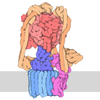[English] 日本語
 Yorodumi
Yorodumi- PDB-6kjo: The microtubule-binding domains of yeast cytoplasmic dynein in th... -
+ Open data
Open data
- Basic information
Basic information
| Entry | Database: PDB / ID: 6kjo | |||||||||||||||
|---|---|---|---|---|---|---|---|---|---|---|---|---|---|---|---|---|
| Title | The microtubule-binding domains of yeast cytoplasmic dynein in the low affinity state | |||||||||||||||
 Components Components | Dynein heavy chain, cytoplasmic | |||||||||||||||
 Keywords Keywords |  MOTOR PROTEIN / MOTOR PROTEIN /  Microtubule / Microtubule /  Dynein / Dynein /  disulfide bond / low affinity disulfide bond / low affinity | |||||||||||||||
| Function / homology |  Function and homology information Function and homology information karyogamy / establishment of mitotic spindle localization / astral microtubule / nuclear migration along microtubule / minus-end-directed microtubule motor activity / karyogamy / establishment of mitotic spindle localization / astral microtubule / nuclear migration along microtubule / minus-end-directed microtubule motor activity /  cytoplasmic dynein complex / dynein light intermediate chain binding / cytoplasmic dynein complex / dynein light intermediate chain binding /  spindle pole body / nuclear migration / dynein intermediate chain binding ... spindle pole body / nuclear migration / dynein intermediate chain binding ... karyogamy / establishment of mitotic spindle localization / astral microtubule / nuclear migration along microtubule / minus-end-directed microtubule motor activity / karyogamy / establishment of mitotic spindle localization / astral microtubule / nuclear migration along microtubule / minus-end-directed microtubule motor activity /  cytoplasmic dynein complex / dynein light intermediate chain binding / cytoplasmic dynein complex / dynein light intermediate chain binding /  spindle pole body / nuclear migration / dynein intermediate chain binding / mitotic sister chromatid segregation / establishment of mitotic spindle orientation / cytoplasmic microtubule / cytoplasmic microtubule organization / Neutrophil degranulation / mitotic spindle organization / spindle pole body / nuclear migration / dynein intermediate chain binding / mitotic sister chromatid segregation / establishment of mitotic spindle orientation / cytoplasmic microtubule / cytoplasmic microtubule organization / Neutrophil degranulation / mitotic spindle organization /  cell cortex / cell cortex /  ATP hydrolysis activity / ATP hydrolysis activity /  ATP binding / ATP binding /  cytoplasm cytoplasmSimilarity search - Function | |||||||||||||||
| Biological species |   Saccharomyces cerevisiae (brewer's yeast) Saccharomyces cerevisiae (brewer's yeast) | |||||||||||||||
| Method |  SOLUTION NMR / SOLUTION NMR /  simulated annealing simulated annealing | |||||||||||||||
 Authors Authors | Nishida, N. / Komori, Y. / Takarada, O. / Watanabe, A. / Tamura, S. / Kubo, S. / Shimada, I. / Kikkawa, M. | |||||||||||||||
| Funding support |  Japan, 4items Japan, 4items
| |||||||||||||||
 Citation Citation |  Journal: Nat Commun / Year: 2020 Journal: Nat Commun / Year: 2020Title: Structural basis for two-way communication between dynein and microtubules. Authors: Noritaka Nishida / Yuta Komori / Osamu Takarada / Atsushi Watanabe / Satoko Tamura / Satoshi Kubo / Ichio Shimada / Masahide Kikkawa /  Abstract: The movements of cytoplasmic dynein on microtubule (MT) tracks is achieved by two-way communication between the microtubule-binding domain (MTBD) and the ATPase domain via a coiled-coil stalk, but ...The movements of cytoplasmic dynein on microtubule (MT) tracks is achieved by two-way communication between the microtubule-binding domain (MTBD) and the ATPase domain via a coiled-coil stalk, but the structural basis of this communication remains elusive. Here, we regulate MTBD either in high-affinity or low-affinity states by introducing a disulfide bond to the stalk and analyze the resulting structures by NMR and cryo-EM. In the MT-unbound state, the affinity changes of MTBD are achieved by sliding of the stalk α-helix by a half-turn, which suggests that structural changes propagate from the ATPase-domain to MTBD. In addition, MT binding induces further sliding of the stalk α-helix even without the disulfide bond, suggesting how the MT-induced conformational changes propagate toward the ATPase domain. Based on differences in the MT-binding surface between the high- and low-affinity states, we propose a potential mechanism for the directional bias of dynein movement on MT tracks. | |||||||||||||||
| History |
|
- Structure visualization
Structure visualization
| Structure viewer | Molecule:  Molmil Molmil Jmol/JSmol Jmol/JSmol |
|---|
- Downloads & links
Downloads & links
- Download
Download
| PDBx/mmCIF format |  6kjo.cif.gz 6kjo.cif.gz | 454.9 KB | Display |  PDBx/mmCIF format PDBx/mmCIF format |
|---|---|---|---|---|
| PDB format |  pdb6kjo.ent.gz pdb6kjo.ent.gz | 382.3 KB | Display |  PDB format PDB format |
| PDBx/mmJSON format |  6kjo.json.gz 6kjo.json.gz | Tree view |  PDBx/mmJSON format PDBx/mmJSON format | |
| Others |  Other downloads Other downloads |
-Validation report
| Arichive directory |  https://data.pdbj.org/pub/pdb/validation_reports/kj/6kjo https://data.pdbj.org/pub/pdb/validation_reports/kj/6kjo ftp://data.pdbj.org/pub/pdb/validation_reports/kj/6kjo ftp://data.pdbj.org/pub/pdb/validation_reports/kj/6kjo | HTTPS FTP |
|---|
-Related structure data
| Related structure data |  9996C  9997C  6kioC 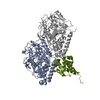 6kiqC 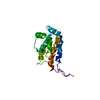 6kjnC C: citing same article ( |
|---|---|
| Similar structure data | |
| Other databases |
- Links
Links
- Assembly
Assembly
| Deposited unit | 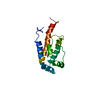
| |||||||||
|---|---|---|---|---|---|---|---|---|---|---|
| 1 |
| |||||||||
| NMR ensembles |
|
- Components
Components
| #1: Protein | Mass: 16525.951 Da / Num. of mol.: 1 / Fragment: The microtubule-binding domain / Mutation: S3097C, V3222C Source method: isolated from a genetically manipulated source Source: (gene. exp.)   Saccharomyces cerevisiae (strain ATCC 204508 / S288c) (yeast) Saccharomyces cerevisiae (strain ATCC 204508 / S288c) (yeast)Strain: ATCC 204508 / S288c / Gene: DYN1, DHC1, YKR054C / Plasmid: pET-15b / Cell (production host): BL21(DE3) / Production host:   Escherichia coli (E. coli) / References: UniProt: P36022 Escherichia coli (E. coli) / References: UniProt: P36022 |
|---|
-Experimental details
-Experiment
| Experiment | Method:  SOLUTION NMR SOLUTION NMR | ||||||||||||||||||||||||||||||||||||||||||||||||||||||||||||||||||||||||
|---|---|---|---|---|---|---|---|---|---|---|---|---|---|---|---|---|---|---|---|---|---|---|---|---|---|---|---|---|---|---|---|---|---|---|---|---|---|---|---|---|---|---|---|---|---|---|---|---|---|---|---|---|---|---|---|---|---|---|---|---|---|---|---|---|---|---|---|---|---|---|---|---|---|
| NMR experiment |
|
- Sample preparation
Sample preparation
| Details |
| |||||||||||||||
|---|---|---|---|---|---|---|---|---|---|---|---|---|---|---|---|---|
| Sample |
| |||||||||||||||
| Sample conditions | Ionic strength: 200 mM / Label: conditions_1 / pH: 7.0 / Pressure: 1 atm / Temperature: 298 K |
-NMR measurement
| NMR spectrometer | Type: Bruker AVANCE III / Manufacturer: Bruker / Model : AVANCE III / Field strength: 800 MHz : AVANCE III / Field strength: 800 MHz |
|---|
- Processing
Processing
| NMR software |
| ||||||||||||
|---|---|---|---|---|---|---|---|---|---|---|---|---|---|
| Refinement | Method:  simulated annealing / Software ordinal: 2 simulated annealing / Software ordinal: 2 | ||||||||||||
| NMR representative | Selection criteria: lowest energy | ||||||||||||
| NMR ensemble | Conformer selection criteria: structures with the lowest energy Conformers calculated total number: 200 / Conformers submitted total number: 10 |
 Movie
Movie Controller
Controller








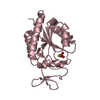



 PDBj
PDBj




